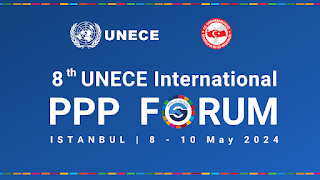Stakeholder participation in PPPs: Enhancing stakeholder engagement in PPPs for the SDGs'.
Felix Dodds - Stakeholder participation in PPPs
This is a presentation I made on May the 8th at the 8th UNECE International Public-Private Partnerships Forum in Istanbul as part of the Panel 'Stakeholder participation in PPPs: Enhancing stakeholder engagement in PPPs for the SDGs'.
Thanks – this is a subject close to my heart perhaps
understandable as for twenty years I ran an organization called Stakeholder
Forum for a Sustainable Future that took seriously Agenda 21 and the nine chapters
that identified key stakeholders and their rights and responsibilities.
We are here today to offer ideas for what might be in a guide to engage stakeholders in PPP projects. My comments are based on work undertaken by two of my students at the University of North Carolina Elisabeth Butler and Ranger Ruffins who developed for the UN Sendai Review a similar guide which hasalso been used for the Voluntary National Reviews for the SDGs.
First and foremost, the engagement of stakeholders in any PPP project has to be at its core for it to gain support within the community it is servicing. By not doing so such PPPs will be in danger of being opposed by those that it is set up to help as they will feel they have had no say. It is not guaranteed that involving stakeholders will ensure everyone is happy with the outcome, but it will ensure a better outcome and the possibility of those it is serving feeling that it reflects some if not all their input.
So let me go over a number of the Important Considerations Before Engaging Stakeholders
Purpose and Goals - Considering the challenges of stakeholder engagement, those seeking to engage stakeholders must first clarify the overall purpose and goals of the project in question. Stakeholder facilitators will have an easier time accessing the untapped potential of stakeholder engagement processes once the project duration, scope, desired outcomes, and resource and personnel availability are defined.
Rasons to Engage Stakeholders - Stakeholder engagement can build trust, commitment, and buy-in from stakeholders, help decision makers fairly assess all facets of a situation in a holistic manner, and facilitate the implementation process. It is vital to develop clear expectations and a plan of action before involving stakeholders, so as to not waste stakeholders’ time and energy.
Gather Information – Most engagement with stakeholders has a core element the gathering of information and opinions. This should be undertaken in a very transparent way to all stakeholders engaged. If some is commercially sensitive then there should be a way of expressing this that encompasses the information without compromising the sensitivity. The outputs from the process should be available to all.
Build Capacity – Not all stakeholders have the same capacity to engage. Any engagement needs to do a capacity review and support those that need extra skill development or funding assistance. Addressing the participation gaps and power imbalances is critical to the success of any stakeholder engagement.
Reach Consensus – defining if consensus is required for the engagement or that if not then how the views of those who disagreed might be reflected will help address conflicts.
Important Considerations – Do the project leaders have sufficient resources to effectively engage stakeholders? (i.e., time, personnel, funding, technology, jargon-free content, language translations) – engaging meaningfully with stakeholders is not quick, cheap or easy.
Moving on to the second question I was asked to address - What are the main areas that a UNECE guide on the topic needs to cover?
To help with the visualisation the guide produced by University of North Carolina developed what we call the UNC Snow Angel method.
It places groups with greater vulnerability, power, or knowledge at the center of stakeholder identification and recruitment. incorporates a depth component that symbolizes stakeholders placed in the center of the snow angel carry more weight in the decision-making process.
Think of the depth component as the imprint you make when you create a snow angel. The heavier parts of your body, such as your torso and core, will leave a deeper imprint than lighter body parts, such as your arms.
Our method indicates stakeholder engagement increases as you get closer to the center of the snow angel. Stakeholders who are greatly impacted by the decisions being made or who have significant influence over the decision-making process are more likely to demonstrate greater interest and commitment than those who have less of a stake in the discussed matter.
On the other hand, the number of identified stakeholders will increase as you move away from the center of the snow angel. The Stakeholders placed at the extremities of the snow angel wings will have less relevance to the project.
We have five steps that we believe are critical to the PPP guide.
1. Level of Engagement - To what extent would stakeholders like to be involved, and to what extent are the stakeholder facilitators able and willing to engage stakeholders. Think of stakeholder engagement as a spectrum that ranges from minimal stakeholder participation to maximum stakeholder participation. As mentioned with the UNC Snow Angel.
Vulnerable groups may not have the time, capacity, resources, power, or influence to participate in a project, so stakeholder facilitators must intentionally find ways to include the voices of these groups without overwhelming them. Setting clear expectations are critical.
2. Trust and Transparency - Trust is the foundation of any relationship, and a lack of trust will undermine the efforts of any initiative. Mistrust can result in withheld information, hostility, and lack of cooperation, which leads to inefficient and ineffective stakeholder engagement.
Stakeholder facilitators must create a transparent, open, and respectful environment in order to build trust among themselves and with stakeholders.
3. Closing the Participation Gap - refers to stakeholder facilitators giving stakeholders the necessary tools, resources, and space to participate fully in the stakeholder engagement process. Stakeholder facilitators may provide stakeholders with information, funding, technology, jargon-free content language translations, or other assets needed to improve stakeholders’ participation capacity.
The need to address power gaps and imbalance among stakeholders is critical to success.
4. Diversity, Equity, and Inclusion - Based on differences in culture, background, personality, and lived experiences, each stakeholder brings a unique perspective to the table.
Diversity among stakeholders can help stakeholder facilitators assemble a more complete picture of the presented challenge, as well as prevent biases from negatively impacting the decision-making process. Stakeholder facilitators must create an environment in which diversity, equity, and inclusion (DEI) is considered normal.
5. Accountability - To ensure success, stakeholder facilitators must establish accountability the integration of the principles of inclusivity, materiality, and responsiveness into the governance, strategy, and operations of an organization.
Inclusivity refers to including stakeholders in the decision-making process, materiality refers to clearly identifying the issue at hand, and responsiveness refers to an organization’s response to stakeholder matters.
Final thoughts
Stakeholder engagement is an ongoing and dynamic process. Even after concluding the five steps outlined above, you may at any time go back and revisit any step of the process. The UNC Guide also provides some thought-provoking questions to help you think through how to structure stakeholder engagement processes, but it is important to remember that each stakeholder engagement process is unique and what works for someone else may not necessarily work for you.
To really create a holistic stakeholder engagement process, you must remember to look at what you are dealing with from many different angles, perspectives, and lenses.
Engaging stakeholders is like putting together the
pieces of a puzzle in a constantly evolving landscape. A picture may emerge,
but the picture may only be a temporary reflection of a larger picture at play.
There is no perfect way to engage stakeholders, but, with enough awareness,
clarity, and flexibility, you should be able to build the connections and
relationships needed to accomplish what you set out to do.
Kader Asmal chair of the World Commission on Dams.
“A parting warning: doing so [conducting an MSP] is
never a neat, organized, tidy concerto.
More often, the process becomes a messy, loose-knit,
exasperating, sprawling cacophony.
Like pluralist democracy, it is the absolute worst
form of consensus-building except for all the others.”




Comments
Post a Comment